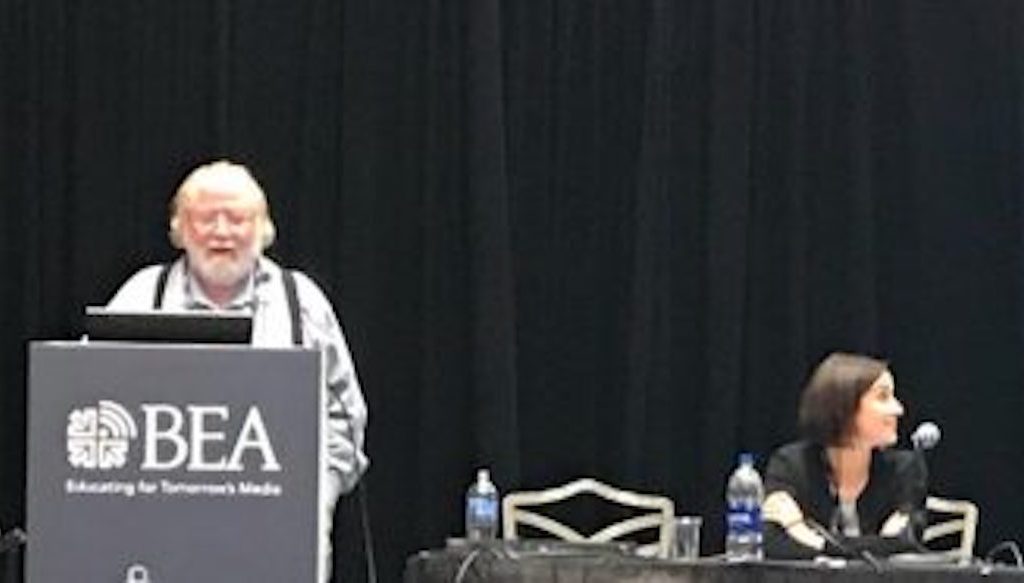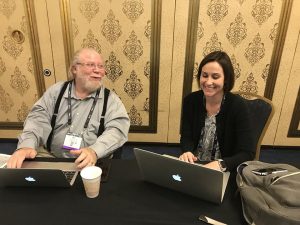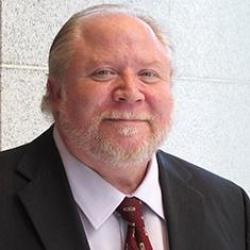Journalism educators take on fake news


Eric Newton and Kristy Roschke
At the Broadcast Education Association convention this weekend in Las Vegas, a quartet of back-to-back “power panels” looked at fake news. It was refreshing to see a full room considering the problems of solutions of counterfeit stories in the digital age, but it was also clear there’s a long way to go.
In the first panel, “Detecting Fake News,” Lance Liguez of the University of Texas/Arlington showed a few widely circulated fakes, including the Nazi sub found near Niagra Falls (it wasn’t) and the Seahawks player burning a flag in the locker room (he didn’t). Hoaxes, Liguez said, are designed to 1) trick people into sharing them, 2) at times, make money, 3) inflame emotions and 4) drive opinion.
Deb Wenger of the University of Mississippi, a trainer with the newly renamed Google News Initiative, showed a simple way to detect phony images: Google reverse image search, or, if you use the Chrome browser, just right click on the image and pick the menu option to show you where the photo has appeared on line.
Sometimes, news literacy is just common sense, as with a phony story about a Mississippi husband and wife who supposedly learned they were brother and sister after a DNA test. Yet major news organizations were fooled. Tipoffs: No reporter’s name, no specifics in the story, no legit stories on the site, whois.com shows the site owner isn’t a real news company — or you can just Google the story text.
Mark Tremayne of the University of Texas/Arlington talked about how even obvious fakes — such as Obama Opens First Concentration Camps in the US — were pushed by social media algorithms that identified “trending topics.” Tremayne and colleagues are working on a new tool. The prototype, Talking Cricket, is designed to detect bots and falsehoods in Tweets. Not surprisingly, bot detection is easier than understanding why humans share fake news.
Three lessons have emerged, Tremayne said: “Fake” is hard to define, a market for “truth” must improve, and a “culture of credibility” must emerge. There will be earlier results on a test of the tool this summer.
In our panel, “Why News Organizations Should Make News Literacy Part of Their Mission,” we focused on the estimated 50 to 80 million American adults who want help in better finding and understanding news and information online. The rise of the “fake news” debate in the past two years offers, among other things, a chance for news organizations to better engage with their communities and be more transparent about how and why journalists seek to verify and clarify the news. What’s more, we said, “If journalists and journalism educators don’t help people understand how news works, who will?”
We talked about what we’re doing at the News Co/Lab to bring together folks from across ideologies, disciplines, borders and ages to improve the health of our information ecosystems on the supply and demand side, including highlighting best practices from newsrooms and organizations around the world. We then emphasized the role news organizations should play in educating audiences on the journalism process and helping them become critical media users, as well as the important role technology platforms, particularly in social media, play in promoting legitimate news.
We then provided recommendations for expanding the reach of news literacy education. Rather than compartmentalizing news literacy lessons within a particular discipline at the K-12 or college level, we suggested that news literacy principles should be introduced and practiced across all subject areas. And because news literacy is practiced over a lifetime, it’s also important to provide educational opportunities for adults. A recent crop of online classes from the Cronkite School, First Draft and the Knight Center at UT-Austin, among others, are helping fill the gap in news literacy education for informal learners.
Finally, we shared some ideas for what newsroom can do to introduce greater transparency in their reporting and engage in a meaningful way with community. One example was a new behind-the-scenes show from student-run Cronkite News called Full Circle. We ended by emphasizing the urgency with which news organizations should react to continued erosion of credibility perpetuated by the fake news phenomenon, again asking: “If journalists and journalism educators don’t help people understand how news works, who will?”
The third panel, “Focusing on B.S. in Broadcast News,” brought insights into the label of “fake news.” Ryan Rogers of Butler University, discussed his research on the “irrelevance of veracity”, showing, among other things, that the content of the message can mean less than the label. If a story does not support your preconceived beliefs — and if it’s also labelled fake news — that story can really upset you.
Philip Scepanski of Marist College said a challenge in a general media literacy class is how to cover social media in a short time. His solution: Students should write a headline and briefly describe a fake political news story that they think would spread in their social media networks. The results illustrated the student’s beliefs, and they led to the observation that political engagement is rising.
Chris Swindell, a critical theorist from Marshall University, said fake news has created a cognitive dissonance among media organizations such that journalists are complicit in degrading the trust of the entire profession when they label each other as fake news.
Kevin L. Stoker from the University of Nevada/Las Vegas said true B.S.-artists don’t actually care about the truth, they only care about what you think of them. Fake new accusations say more about the person making the accusations than it does the accused source. Journalists should be sincere, show their true character and be authentic. “Maybe the challenge for us is to trust the audience more,” he said.
The last group took on “The Credibility Crisis” by looking at the effect of fake news accusations on audience trust. Ginger Blackstone of Harding University said it has become socially acceptable to distrust mainstream media. Angela Zhang of Kansas State said that the situation meets the criteria of a true public relations crisis. Faster responses to errors are important, she advised, and when media are wrongly attacked, they should fight back. If the attack comes on social media, then so should the response.
Ronen Shay of St. John Fisher College said the responses being discussed by Facebook — verifying users and advertisers, political ad labeling, user reporting, hiring safety and security staff — are indeed improvements, but do not go far enough. He also mentioned Twitter’s suspension of bot accounts and Russian propaganda accounts, as well as Google’s banning of foreign news sites that mask their country of origin and revamping their search criteria to push down “low quality” content. Shay said, however, that the companies are not transparent enough to allow oversight of many of the measures.
Citizens who are not happy with flows of fabricated content have options, Shay said, including user boycotts and advertiser withdrawals that change a social media company’s performance metrics. He suggests applying the dual responsibility model — if you are providing a social service, such as electricity, you would fall under more utility-like regulation.
Jon Borden of Syracuse University said media outlets that accuse each other of “fake news” hurt each other. “A threat to media credibility anywhere,” he said “is a threat to media credibility everywhere. … We’re undermining each other’s credibility.” Borden said news organizations tend to apologize rapidly and sometimes not completely, but resist fighting back. “Don’t throw your reporters under the bus for good work.”
Spending five hours with colleagues studying, teaching and acting on news literacy only whetted our appetite for more!

Eric Newton is a global leader in the digital transformation of news and a key figure in the creation of news literacy. As the Innovation Chief, he drives change and experimentation at Cronkite News, the news division for Arizona PBS.
